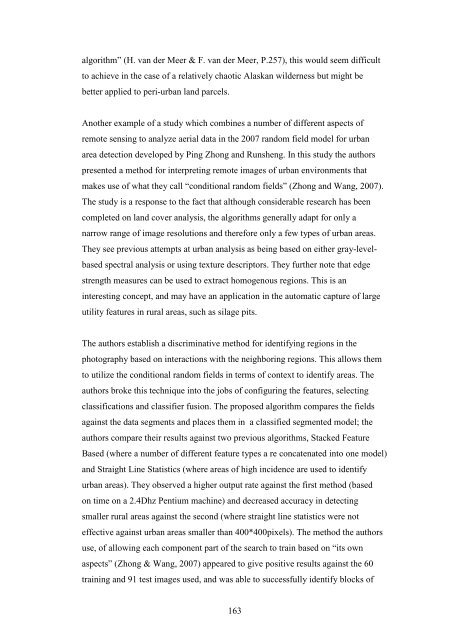You also want an ePaper? Increase the reach of your titles
YUMPU automatically turns print PDFs into web optimized ePapers that Google loves.
algorithm” (H. van der Meer & F. van der Meer, P.257), this would seem difficult<br />
to achieve in the case of a relatively chaotic Alaskan wilderness but might be<br />
better applied to peri-urban land parcels.<br />
Another example of a study which combines a number of different aspects of<br />
remote sensing to analyze aerial data in the 2007 random field model for urban<br />
area detection developed by Ping Zhong and Runsheng. In this study the authors<br />
presented a method for interpreting remote images of urban environments that<br />
makes use of what they call “conditional random fields” (Zhong and Wang, 2007).<br />
The study is a response to the fact that although considerable research has been<br />
completed on land cover analysis, the algorithms generally adapt for only a<br />
narrow range of image resolutions and therefore only a few types of urban areas.<br />
They see previous attempts at urban analysis as being based on either gray-level-<br />
based spectral analysis or using texture descriptors. They further note that edge<br />
strength measures can be used to extract homogenous regions. This is an<br />
interesting concept, and may have an application in the automatic capture of large<br />
utility features in rural areas, such as silage pits.<br />
The authors establish a discriminative method for identifying regions in the<br />
photography based on interactions with the neighboring regions. This allows them<br />
to utilize the conditional random fields in terms of context to identify areas. The<br />
authors broke this technique into the jobs of configuring the features, selecting<br />
classifications and classifier fusion. The proposed algorithm compares the fields<br />
against the data segments and places them in a classified segmented model; the<br />
authors compare their results against two previous algorithms, Stacked Feature<br />
Based (where a number of different feature types a re concatenated into one model)<br />
and Straight Line Statistics (where areas of high incidence are used to identify<br />
urban areas). They observed a higher output rate against the first method (based<br />
on time on a 2.4Dhz Pentium machine) and decreased accuracy in detecting<br />
smaller rural areas against the second (where straight line statistics were not<br />
effective against urban areas smaller than 400*400pixels). The method the authors<br />
use, of allowing each component part of the search to train based on “its own<br />
aspects” (Zhong & Wang, 2007) appeared to give positive results against the 60<br />
training and 91 test images used, and was able to successfully identify blocks of<br />
163
















